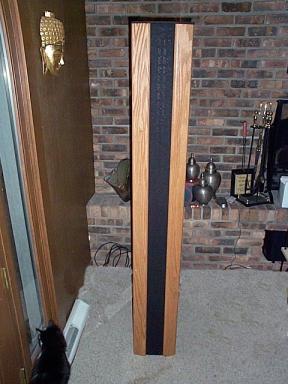Product Review - Soundline Audio
SL-3 Ribbon-Dynamic Hybrid Speakers - May, 2000
John Kotches
![]()
|
|
Design:
Two-way Ribbon/Dynamic hybrid, bass reflex enclosure MFR:
40 Hz – 20 KHz ±
3 dB Crossover
Frequency: 259 Hz Crossover
Slope: 12dB/Octave Sensitivity:
88 dB/1w/1m Recommended
Amp power: 10 - 200 Watts Dimensions
(H/W/D): Ribbon
Panel: 65 3/4" / 9 1/4” /
2” Woofer
Enclosure: 20” / 9 1/4” /
20” Overall:
65 3/4” / 9 1/4” / 20” Weight:
65 Pounds Each MSRP:
$2,195 (Oak/Maple/Black Oak) - Sold Factory Direct Only Options:
$100 for Zebrawood
finish,
|
| Soundline Audio; Web http://www.soundlineaudio.com |
Introduction
How does a new manufacturer get started in the audio business? Typically, it's the “Brick and Mortar” (B&M) model. With B&M, usually the manufacturer sells product through a distributor or, less frequently, directly to the retailer. The key to this model is getting the product in the retailers' hands. If the manufacturer can afford the cost, training the retailers on demonstrating the product to reveal its optimal use is also done. The problem for the retailer is that some manufacturers require a substantial investment in minimum inventories for a company that has yet to build a track record. This can be a stumbling block to getting retailers to stock and sell the product. Once the product is in the retailer's environment, it is up to the retailer to demonstrate the product effectively. For the consumer, this is still a mixed bag since the retailers' auditioning room has little to do with how the product will actually sound in their home, in their system. Most quality retailers allow an in-home audition so that the customer gets a feel for how things sound in their own home.
Another
option available is for the manufacturer to go the factory-direct route.
As the Internet becomes more ingrained into our culture, it's
possible to deliver information about products for a (relatively) modest
investment. But, with
factory-direct sales and no retail channel presence, how does a start-up
manufacturer get the word out? Sometimes,
it's the old-fashioned way – with an ad in a printed publication. Soundline
Audio, whose product, the SL-3 loudspeaker, is under review here, caught my attention with such an ad.
I happened across it in the final edition of Audio, and had I
not seen the ad, I wouldn't have known about the company.
This leads us to the other method for getting the word out about a new
product, via magazine reviews, be they print magazines, or web-zines, like Secrets
of Home Theater and High Fidelity.
Design and Construction
The SL-3s utilize a ribbon midrange/tweeter and dynamic woofer. All of Soundline Audio's stereo pair speakers (the SL-1 through SL-5) crossover to the mid/tweeter ribbon at 250 Hz. Musicians, take note, everything from about middle C upwards on the piano keyboard is covered by the mid/tweeter ribbon section. If you're counting, that's 6+ octaves for the mid/tweeter ribbon , with only 3+ octaves below 250 Hz covered by the woofer section.
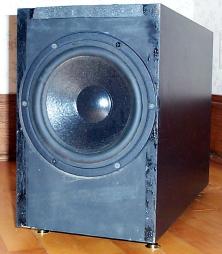 |
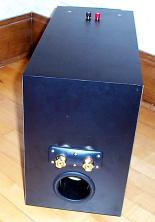 |
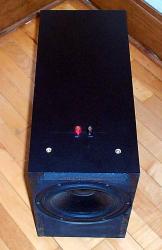 |
The
woofer is an 8" cone, made to Soundline Audio's specifications by a 3rd
party manufacturer, and optimized for the bass reflex enclosure.
The enclosure houses the binding posts from the amp to the speaker on
the rear of the cabinet.
The binding posts are ruggedly constructed 5-ways, which accept
1/2" spade lugs, banana plugs, or up to 10 gauge wiring through the center
hole or around the post. I didn't try pins, so I can't tell you how well they work
with these binding posts. You
don't need to break out your binding post wrench, because they have nicely spaced
indentations which allow you to get very solid fastening to bare wire or spade
lugs using just your fingers. The
rear also has the port that supports its bass reflex design.
The top of the enclosure has binding posts for the
crossover's high-pass output to the
mid/tweeter ribbon section (see my “Areas for Improvement” below for commentary
on these binding posts). It also
has the lock nuts for screwing down the mid/tweeter ribbon panel to the woofer
enclosure.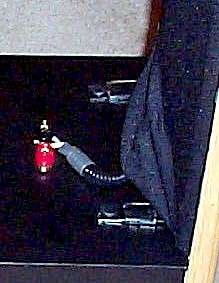
The mid/tweeter ribbon panel is perforated at the bottom in front of the woofer. The ribbon itself is 49" in length and begins about an inch above the top of the woofer enclosure in the panel. The mid/tweeter ribbon is built by a 3rd party manufacturer, again per Soundline Audio's specifications. The ribbon panel (frame) is 65 3/4" high, 9 1/4" wide and a scant 2" deep.
Assembling
the speaker is a pretty simple task but because of their size they're a bit unwieldy.
I used a two-wheeler to move them from my living room assembly area to
my home theater (ok, the family room).
You'll need floor space, with at least 6 feet
Listening to the SL-3s
My
first listening impressions of the SL-3 are summed up in three words
“Bright, bright, bright”.
There
was a metallic sharpness to most of the treble (too much sheen on the cymbals)
and sibilance so present that they were nearly unlistenable.
I started extended break-in over the next week, with the speakers
playing music of various types, non-stop – except for the small periods of time
that my wife demanded quiet.
I'd
listen some more each night and would find them just a little less harsh, and
a little more relaxed in their presentation.
About 5 days into the process, either I was accustomed to their sound,
or the ribbons had enough hours of playing time on them.
Either way, I knew I was definitely enjoying their presentation, and
the serious listening was about to get under way.
I
listen to a variety of music – and you'll hear me referencing plenty of
acoustic jazz. I've listed some
of the highlights of my listening sessions, to give you an idea of how they
sounded to my ears.
One
recording I've listened to again and again is John Coltrane's
"Giant Steps". This is a classic
recording of the tenor giant, and it is a great jazz recording.
Even though the recording is over 40 years old, it's an excellent
example of how good a job could
be done then. Off kicks the title
track, and I'm keeping time on the cymbal with my right hand – the
presentation is smooth, natural, and relaxed.
Art Taylor's ride cymbal is accurately reproduced – propelling the
group through their incredibly frenzied pace.
During Coltrane's improvisation, even with the notes flying out of
his instrument (at an incredible 720/minute), they were clearly delineated from
the top of his horn to the “barking” produced at the bottom of his
instrument. Moving on to
the beautiful “Naima”, these speakers catch all the delicacy Coltrane is
coaxing from his horn. These
speakers display the contrast very well between Coltrane's hard bebop / all
out swinging and the warmth he had on ballads.
For
fun, I pulled out Supertramp's "Breakfast in America".
I really enjoy the title cut where you hear trombone, tuba, and
clarinet
– not your usual pop fare instrumentation!
During the harmonies, the line source produced a vertical illusion, as
though the voices were stacked one atop the other on the left and right
speakers. Ah, the power of a
line source transducer. There's a clarinet interlude, and with poor speakers,
it's difficult to tell whether the instrument is a clarinet or a soprano
sax. If you're aware of
what's going on, the break from the clarion to the throat register is a dead
giveaway. On the SL-3s, there is
no question it's a clarinet, with a bright tone in the altissimo register.
I also took the opportunity to turn the volume up for a moment on
Switch
gears, it's time for some Big Band music, from the Bob Mintzer Big Band and
their
Out
comes some Samuel Barber material, “Overture to School for Scandal”. The opening bars have the triangle ringing out over the orchestra, crystal
clear with the various sections of the orchestra.
The cohesiveness of the Symphony is never lost, but the detail of the
various sections parts are never obscured.
In fact, some very low level detail is drawn out nicely in the quieter
moments of this composition, with clarinets nicely accompanying strings.
The oboe during the lyrical midsection is reproduced with the reediness
and warmth unique to the instrument. In
the final bars of the piece, the sharpness of the trumpets with the triangle
are right where they are supposed to be.
What
these speakers don't do, is reproduce the last low octave of music convincingly
and with huge impact. Given that
they're rated down to 40 Hz, I'm not the least bit surprised at this
characteristic of the speakers. Pull
out any of the Telarc recordings
with the huge bass drum, and you'll understand that these speakers don't
quite get the last octave, because the sheer weight of the strikes of this
bass drum aren't carried across – this was the case on a recording of “Mars” from Holst's tone poem collection “The
Planets”.
Using the SL-3s in a Home Theater Environment
Like most people, I have to make do with a combined Stereo and Home Theater listening room. I was able to integrate the SL-3s into my setup pretty well. I wasn't able to get a seamless blend from left to center to right since I don't have all Soundlines across the front. Equally, I was unable to get a perfectly smooth pan from front to rear on the material which contains such panning. Most of my reviewing was done in a two-channel context, but I managed to squeeze in some Home Theater listening as well.
I think many Home Theater reviewers use The Eagles' "Hell Freezes Over" DTS DVD as a reference recording to check out the ability of their system to reproduce multi-channel music. During the opening of “Hotel California”, I was duly impressed – the clarity of the plucked guitar strings off of Don Felder's acoustic guitar was just a little bit better than I'm accustomed too. Background vocals were also a tad bit clearer. Just how many guitars did they use on this track, 100?
I am a big fan of DTS-encoded music CDs, and found myself pulling just about everything out of my arsenal. My most recent pick-up, The Police's "Every Breath You Take - The Classics" was used as well. I use the track “Every Little Thing She Does is Magic”, because it's got a bunch of instruments coming at you from every direction. This tune is supposed to be a lot of fun, and the SL-3s definitely help project that feeling. Stewart Copeland does some superb work on this, getting many interesting timbres from the cymbals in his drum kit.
As far as movie soundtrack reproduction goes, these speakers do a fine job of reproducing music and dialogue from the sides of the mains. They were also capable of reproducing sharp, hard attacks and explosions with (what I think is) convincing realism.
Areas for Improvement in
Construction
These
speakers are production line proofs - they were used to verify that Soundline Audio's
production processes will work. I
found several areas for improvement in these proofs,
so I discussed these with Greg Godfrey and Bob Jantz at Soundline Audio via
e-mail.
Included
here are my suggestions, and I'm posting their replies to these areas verbatim
as they relate to changes from the production proofs.
My
suggestion: The
included speaker spikes have very short tips, making it difficult to decouple
with the floor on thicker carpets.
The spikes also don't allow for tipping the speaker back slightly as
recommended in the assembly instructions.
They're top heavy and have a tendency to tip towards the mid/tweeter
ribbon during assembly and when moving around for placement.
Soundline's
answer: Currently,
production models utilize 4 - 3/8" diameter spike feet which are much longer
to accommodate a greater tilt angle if so desired.
This longer spike also does a great job of punching through even the
thickest of carpet so as to firmly
anchor
the unit to the foundation. These spikes are placed closer to the edges of
the
enclosure and do a great job of
increasing stability. As an option, we also
offer
outrigger feet for the SL3 and SL2 models.
(A order currently in process for
a
customer in Asia is getting these feet.)
They are aluminum (1/2" x 1" bar stock)
and
powder coated in black with spikes at the extremeties.
My
suggestion: The
midrange/tweeter wires are stripped and bare.
Repeatedly connecting and disconnecting the wires results in fraying, with bits of copper strands
separating from the cable. Binding
posts used to attach the ribbon to the woofer enclosure have an unusual 1"
spacing.
Soundline's
answer: The
connection from the ribbon to the binding posts on the top of the
woofer
enclosure now utilizes gold plated binding posts (3/4" spacing), and
the
leads from the ribbon are terminated with gold plated spade lugs.
My suggestion:
No bi-wiring or bi-amping capability seems possible in the speakers
supplied for review. It looks
like the ribbon connection takes its feed directly from the crossover.
Soundline's answer: As an option, if the customer desires it, we can accommodate requests for bi-wiring and/or bi-amping. This is an option and runs an additional $50. Bi-wiring would add another set of binding posts to the rear of the speaker so the signal would run through the high-pass to the ribbon.
All
my suggested areas for improvement appear to have been addressed, but only a true
production line speaker will bear this out.
Conclusion
These are good speakers, with a relaxed, natural presentation, and with excellent retrieval of detail from your sources. What they don't give you is that last low octave or so (from about 38 Hz or so down to ~20 Hz). If you have a good subwoofer that can match the clarity of the rest of the range, then you've got a ticket to some really nice sounds, reproduced full range. In comparison with other speakers within its price range, they represent a good value. I'd be interested to hear what an entire Home Theater from Soundline Audio would sound like.
- John Kotches
![]()
© Copyright 2000 Secrets of Home
Theater & High Fidelity
Return to Table of Contents for this Issue.

